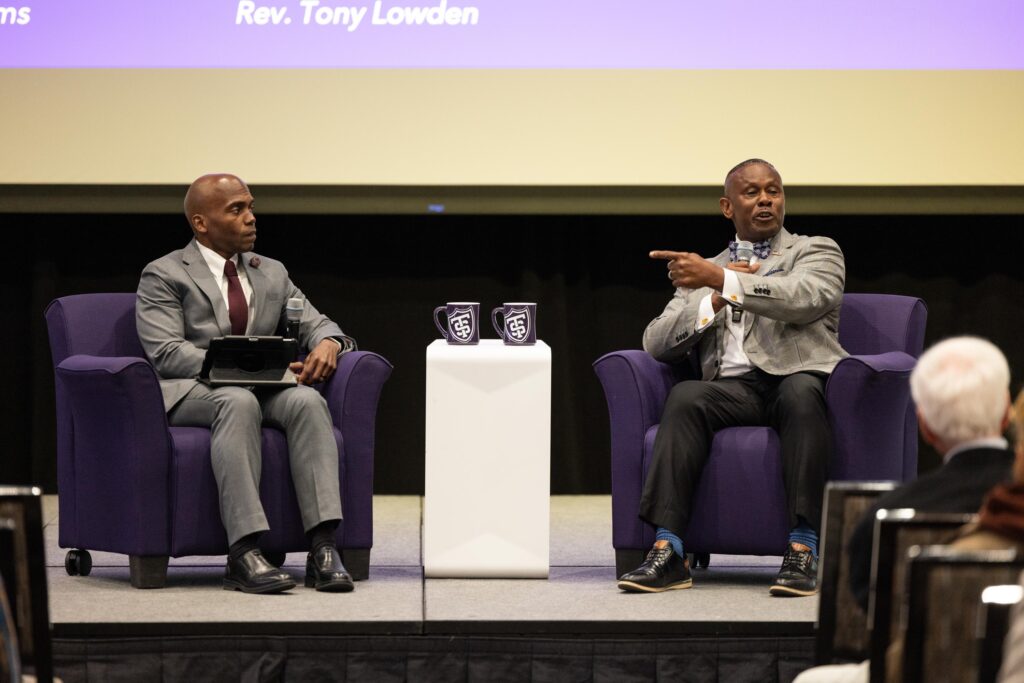Bryan Collier remembers one of the first books that made an impact on his life. When the Maryland native was four, his mother brought home Ezra Jack Keats’ The Snowy Day. Collier remembers identifying with the main character Peter – they looked alike, both loved playing in the snow and even had the same pajamas. The classic 1962 children’s picture book, still popular today, was groundbreaking at the time because it featured an African American as the lead character.
Collier, an award-winning author and illustrator, will be talking about the power of children’s picture books at the Hubbs Children’s Literature Conference hosted by the University of St. Thomas School of Education’s Department of Teacher Education on Saturday, Feb. 16. For nearly three decades, the annual event has drawn teachers, parents, students, librarians, writers and anyone interested in encouraging the use of quality children’s literature in homes, schools and communities. Each year features award-winning national and local authors and illustrators whose books have made an impact in classrooms. Past speakers have included Jacqueline Woodson, Emily Arnold McCully, Marion Dane Bauer, Eric Rohmann, Jane Yolen, Kwame Alexander and Christopher Paul Curtis.
“Entering its 27th year, the Hubbs Children's Literature Conference has put St. Thomas on the list of ‘must attend’ conferences for those who eagerly anticipate its annual celebration of the best in local and national children's literature ,” said the School of Education’s Dr. Robert J. Nistler, who has led the conference’s planning committee for two decades. “Attendees of this daylong event have come to expect opportunities to hear from their favorite authors and illustrators as well as engage in personal conversations with them during conference sessions and book signings.”

Bryan Collier photo by Filip Wolak
Collier has illustrated more than 35 books ranging in topics from prominent African American civil rights leaders and artists to looking at Harlem through the eyes of a young boy and celebrating being a black child. His unique collage and watercolor illustrations have earned numerous Coretta Scott King Awards and Caldecott Honors, along with a nomination for the prestigious Hans Christian Andersen Award.
As an African American children’s book author and illustrator, Collier is in the minority. According to the Cooperative Children's Book Center, a mere 3.3 percent of children’s books from United States publishers in 2017 were written by Africans/African Americans. When it comes to minority characters taking lead roles in children’s books the numbers are also low with 9.1 percent African/African American; 1.2 percent American Indians/First Nations; 8.5 percent Asian Pacific/Asian Pacific Americans and 5.8 percent Latino.
We caught up with Collier to talk about what it means when kids see themselves in a book, why picture books are a vital tool in learning to read and the books that made a difference in his life.
Editor’s note: This interview has been edited for length and clarity.
What are you talking about at the Hubbs Children’s Literature Conference?
I am going to be bridging a connection with the notion that we can never outgrow a picture book. I talk to children all the time, and the older they get they think they outgrow looking at picture books. But they have only partially seen the picture book because we go so fast, we skim past many details. The kind of books that I make are overloaded with details. I want everyone to slow down and really get the full grasp of the subject matter. I’ll start with two of my favorite childhood picture books – The Snowy Day and Harold and the Purple Crayon.
What was it about those books that made a difference in your life?
Peter and I looked alike, I grew up in Maryland and related to snowy days. I was the youngest of six kids, and knew what it was like to be the youngest. In the book, he wanted to play with the big kids in the snowball fights and he was too small, but he created his own world. He made these snow prints in the snow and snow angels.
Then last year I read that book again. I hadn’t read it for over 40 years, and I saw something new in it. It looked like a kid was playing in the snow, but he was doing something else that was bigger, more universal. I get strange looks when I tell kids that he wasn’t playing in the snow, he was dream walking. Just like Harold and the Purple Crayon, that wasn’t crayon play. He was dream walking. He was creating in the fullness of the day. That hit me like a ton of bricks.
I went back to the books that I had done in recent years, like Dave the Potter and Between the Lines: How Ernie Barnes Went from the Football Field to the Art Gallery. Ernie Barnes was a professional football player, as well as an artist, but when he was a kid he used to go outside and do mud paintings with a stick.
Now, I take Ernie with the stick; Harold with the crayon; Peter, who picked up a stick in the book and Dave, who at the end of the book picks up a stick. It looks like they are doing one thing, and they are, but there is a universal fourth dimension that is happening. They are not just doing the dream walking; they are actually creating. That is what I want the kids and all of us to take notice of.
Now you have that opportunity to spark creativity in children through your illustrations.
Yeah, absolutely. I tell them my personal story of going door-to-door to every major publisher once a week for seven years to get a book deal.
What was that like?
They were asking, “What were you doing in between?” It looked like I was just going door-to-door, but guess what I was really doing – I was dreaming. I was creating. I was dream walking, I was honing my craft, and I was never bored with it. The rejection never discouraged me.
Why were you interested in illustrating children’s books?
It just hit me after I graduated from college. I walked into a Barnes & Noble in New York City, and I looked around and did not see any picture books with people of color in them. This was 1989. At this particular moment at this particular store, it just hit me like a ton of bricks, and I said, “Well, I’m going to make some books.” It reminded me of my childhood; it reminded me of The Snowy Day. I didn’t know how hard it was going to be to get somebody to look at your work, to believe that you could make a book.

Illustration by Bryan Collier, a featured speaker at the 2019 Hubbs Children's Literature Conference
What does that mean when children see children who look like them in books?
It means that this other thing happens. It means there is a bigger world you are a part of, and you have importance. You feel there is a connection that happens. If you are a person of color, you rarely see yourself on TV or any of that stuff. When it happens, it’s stunning. Imagine all the stories that haven’t been told, all the kids around the world that never see themselves or anybody they know in books. It is daunting to understand that. The Snowy Day came out in 1962 and that was the first picture book ever printed in mainstream publishing starring an African American kid. We’ve come far, but there is a long way to go for more diversity in picture books.
What role do illustrations play in a child’s learning?
We have reluctant readers, where images are the driving force. It eliminates that anxiety of it. The words come later, but they do come. A visual literacy has to take place because we are in a world filled with tons of imagery. Images are coming at our children and all of us via computer, mobile phones – images on top of images. Part of the purpose of picture books is to create a sense of discernment about what you are reading, what you are looking at, and see if it matches up.
How do illustrations help kids read?
When a kid sees an image and tries to articulate what they are actually seeing from page to page, they are automatically drawn to a verbal setting where they have to try to articulate what they are seeing even if they say it in their own head. That is first pointing to the word itself. The words I have in my books are minimal, and I like it that way. The clarity is all there.
I want kids to see themselves or their friends or someone they know. I use family and friends to pose for the work. My daughter is in all in those books and my neighbors – I put every kid in this neighborhood in the books (I live in upstate New York). When I lived in New York City, I had my nephew walking around Harlem posing for that [Uptown].
Children are using technology more than ever these days to learn. What still makes picking up a book special?
It is that tactile quality, the sound of the pages turning. Picture books are on the computer as well and they thought 10 years ago, it was going to kill the book itself, but it never did. That did not happen because you would miss the dynamic of either a parent or a person reading to a kid, or a kid picking up a book and curling up with it in the corner. I was never worried because I know how powerful that dynamic is – the act of reading a book, holding a book, flipping it upside down and looking at everything about it.







